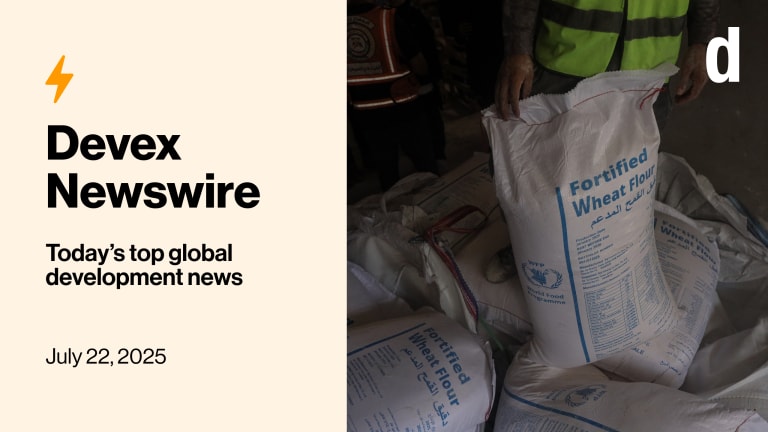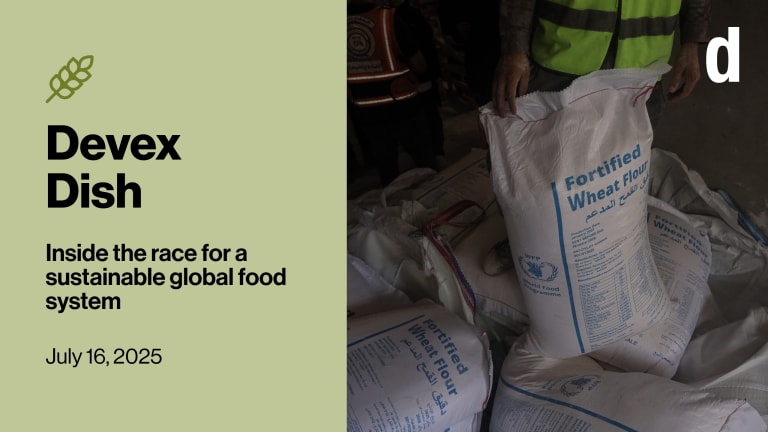What good is in-kind food aid?
With U.S. in-kind food aid declining, the question is timely — but the answer is anything but simple.
As the U.S. slashes its foreign aid budget, it raises a fundamental question: Does the world still need in-kind food aid at all? The United States is by far the largest provider of food aid globally. For decades, much of that assistance has taken the form of shipping American-grown corn, wheat, or soy across oceans to places in crisis — a model exemplified by the Title II Food for Peace program. In fiscal year 2023, Food for Peace provided approximately $2 billion in assistance, reaching 45 million people across 35 countries, with the majority of its operations focused on Africa. But that budget is now at risk of being cut roughly in half following the Trump administration's aid reductions. In-kind food aid has undeniably saved lives during emergencies, reaching people who cannot grow their own food or who have been displaced by conflict or disasters. But critics question whether shipping U.S. grain thousands of miles across the world is really the best or most efficient way to help. They argue the model is expensive, distorts local markets, and persists largely because of domestic U.S. politics: The U.S. government buys grain from American farmers for these programs, effectively guaranteeing them a market for their crops. That guarantee is politically popular in agriculture-heavy states and has helped sustain strong bipartisan congressional support for in-kind food aid, even as other foreign assistance programs have faced cuts. This debate over the future of food aid comes at a time when cash-based assistance is gaining ground and many countries are investing in feeding themselves. It also coincides with U.S. plans to scale back nonemergency food aid and long-term agricultural programs such as Feed the Future — initiatives once intended to help poorer countries boost their food security and reduce their reliance on U.S. support in the first place. The downsides of in-kind food aid One of the central criticisms of in-kind food aid is its impact on local markets. Large-scale shipments of free food can depress prices, disrupt local production, and discourage investment in agriculture. This issue has been documented over decades. In Malawi, for example, research has found that substantial food aid deliveries contributed to a decline in local cereal production. Even free-market U.S. think tanks have criticized the model. In 2023, the Cato Institute published an analysis describing U.S. in-kind food aid as inefficient, harmful to farmers abroad, and misaligned with market dynamics. The study cited the U.S. Government Accountability Office, which found that sourcing food in the United States and shipping it overseas typically costs around a third more than buying food locally or regionally. These costs are not limited to the long transport distances involved. Erin Collinson, director of policy outreach at the Center for Global Development, pointed to the added expense created by U.S. shipping requirements. “There’s this cargo preference requirement that requires a certain percentage of U.S. commodities that are shipped overseas be transported on U.S.-flagged vessels,” she said. “It does, typically add to the cost and sometimes even the delays in getting food shipped. But there’s always a push from the maritime industry here in the United States to see that strengthened or to see it applied with a kind of heavier hand.” These rules ensure consistent demand for American farmers and shipping companies, making food aid not only a humanitarian program but also a mechanism of domestic economic support. Can Africa feed itself without in-kind aid? Another big question: Is in-kind food aid even necessary at scale anymore? Jonathan Said, vice president for technical expertise at AGRA, an African-led organization dedicated to revolutionizing the continent's agricultural sector, is skeptical. “Our view is that in general, there isn’t … a macro, large-scale need for in-kind food aid,” he said. “Of course, you definitely have pockets, but that’s particularly more caused by conflict and governance issues where there are populations — places like South Sudan and Somalia that do need it.” Said pointed to Tanzania as a leading example of progress: Two decades ago, a single season of poor rainfall could cause maize shortages, whereas today, the country has become a net exporter of both maize and rice. Said emphasized that the next step is to strengthen regional trade so that when one country faces shortages, such as South Sudan, its neighbors with surplus production can help fill the gap. He pointed to recent efforts to enable this kind of trade during droughts in Southern Africa, when countries such as Malawi and Zambia faced difficult harvests but Tanzania had better yields. This approach reflects a broader vision for the continent: not relying indefinitely on shipments of U.S. grain, but building resilient local and regional food systems capable of meeting demand even in times of crisis. But is cash aid really enough? In-kind food aid is often criticized for being costly and inefficient, but it continues to play a critical role in many emergencies where other forms of support may fall short. Dan Gilligan, director of the poverty, gender, and inclusion unit at the International Food Policy Research Institute, or IFPRI, argued that despite these criticisms, in-kind aid has a strong track record of helping families maintain food security and consumption during severe crises, enabling them to recover after disasters like drought or conflict. “There is lots of evidence that that has done a lot of good over the years,” he said. While cash-based assistance has gained traction as an alternative, it is not always a one-size-fits-all solution. Research conducted by Gilligan with the World Food Programme in Ecuador, Uganda, Yemen, and Niger found that cash and food transfers delivered similar results everywhere except for Niger: “The markets in Niger were so weak that people would receive cash and essentially couldn't access a healthy diet,” he said. He also noted that in places with high and unpredictable inflation, recipients often prefer food aid or a mix of food and cash. In countries such as Ethiopia, according to Gilligan’s research, cash transfers typically are not adjusted for inflation, making food assistance a more stable and reliable option. Although cash transfers generally do not lead to inflation overall, Gilligan pointed out that there are exceptions. In cases where demand rises for goods with limited supply, prices can increase sharply. He cited research from the Philippines where inflation linked to cash transfers was severe enough to contribute to higher rates of child stunting. He also noted that in contexts with high and unpredictable inflation, recipients often prefer food aid or a combination of food and cash. Cash transfers are typically not indexed to inflation, meaning they can lose value quickly in fragile economies — and these are often the very settings where crises occur and assistance is most needed. At the same time, Gilligan cautioned that cash transfers can have unintended effects on local markets. While most studies show they do not generally drive inflation, there are documented cases where demand for foods with limited or inelastic supply led to significant price increases. The nutrition argument Another important advantage of in-kind food aid is its ability to deliver fortified foods specifically designed to address micronutrient deficiencies. Gilligan emphasized that deficiencies in nutrients such as vitamin A, zinc, iron, and iodine remain a major global public health challenge. In crisis settings, fortified food aid can be essential to meeting these needs. U.S. food aid often includes these kinds of fortified products. Gilligan explained that American in-kind shipments frequently feature corn-soy blends enriched with multiple micronutrients. He pointed to research from northern Uganda that demonstrated the impact of such programs. “In one study from several years ago, adolescent girls in late primary school had, you know, anemia rates around 20% and they almost fell to zero as a result of them getting access to fortified food. So that's something that cash assistance currently just cannot do,” he said. That’s not to say the United States is the only country capable of delivering fortified food — far from it. India, for example, has had success fortifying staple foods like rice through its public distribution system. But this approach is also complex and has not been without controversy. For countries that currently rely on fortified food aid, developing their own capacity to produce and distribute fortified foods could be an important goal. Politics: The elephant in the room Finally, there is the question of why in-kind food aid continues at such scale despite its many critics. Collinson pointed to the powerful domestic interests that help sustain it: “In-kind food assistance has survived for a real reason. And that has to do with obviously the constellation of domestic constituencies that support it ... particularly those representing states that grow commodities that then are used for food aid programs abroad,” Collinson said. In effect, in-kind aid does more than respond to humanitarian needs — it sustains a guaranteed market for American farmers and shippers, a benefit that haunts every budget debate. The Trump administration has justified deep foreign aid cuts in the name of efficiency, even creating the Department of Government Efficiency to eliminate waste. Yet in-kind food aid has remained politically protected despite its high costs, while longer-term agricultural development programs designed to help countries become more self-sufficient — such as Feed the Future, which boosted agricultural production and market access — were among the first to be scaled back or eliminated. As U.S. food aid budgets shrink and policy debates continue, the question of whether the world still needs in-kind food aid remains open — but for now, it may still be an imperfect but necessary part of the global response to hunger.
As the U.S. slashes its foreign aid budget, it raises a fundamental question: Does the world still need in-kind food aid at all?
The United States is by far the largest provider of food aid globally. For decades, much of that assistance has taken the form of shipping American-grown corn, wheat, or soy across oceans to places in crisis — a model exemplified by the Title II Food for Peace program.
In fiscal year 2023, Food for Peace provided approximately $2 billion in assistance, reaching 45 million people across 35 countries, with the majority of its operations focused on Africa. But that budget is now at risk of being cut roughly in half following the Trump administration's aid reductions.
This story is forDevex Promembers
Unlock this story now with a 15-day free trial of Devex Pro.
With a Devex Pro subscription you'll get access to deeper analysis and exclusive insights from our reporters and analysts.
Start my free trialRequest a group subscription Printing articles to share with others is a breach of our terms and conditions and copyright policy. Please use the sharing options on the left side of the article. Devex Pro members may share up to 10 articles per month using the Pro share tool ( ).
Ayenat Mersie is a Global Development Reporter for Devex. Previously, she worked as a freelance journalist for publications such as National Geographic and Foreign Policy and as an East Africa correspondent for Reuters.








